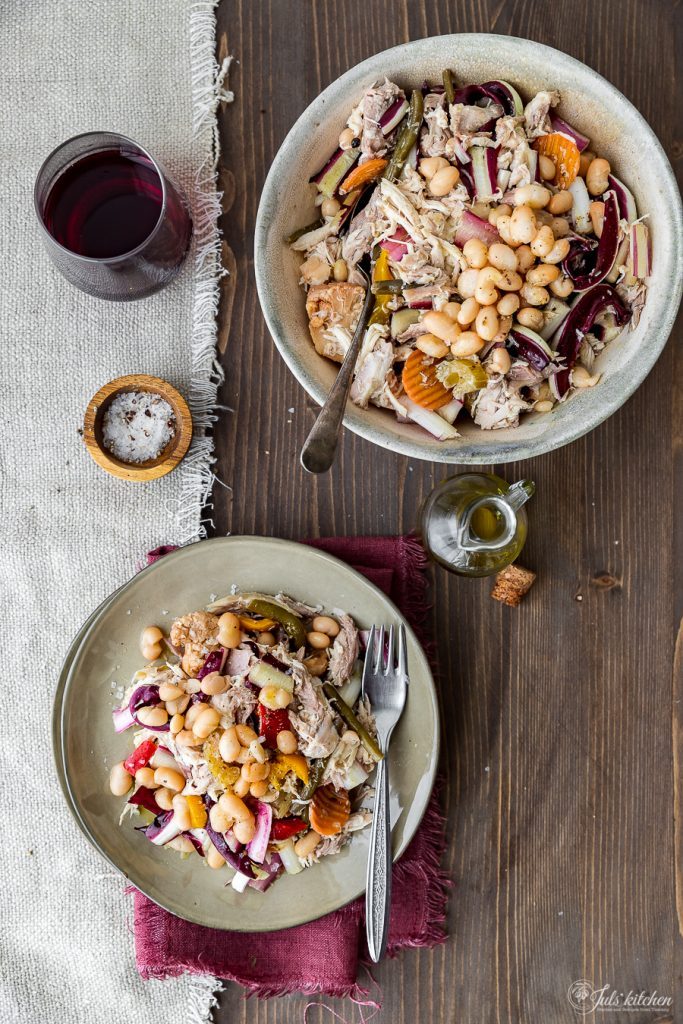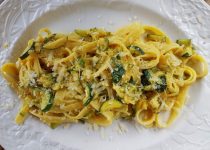Cannellini bean and chicken salad, with pickled giardiniera and radicchio
I go to the market with a straw bag that Tommaso gave me for my birthday last year: on the one hand, it matches my feelings when I shop at the market, as if I were the protagonist of a Joanne Harris novel set in Provence, on the other I can limit my purchases to what I can fit into that.
I take the time to stroll through the market and visit all those producers and sellers who, over the years, have become friends. I buy fruit and vegetables allowing me the luxury of choosing the wild chicory and herbs picked in the fields in the morning, local apples, lemons with a thick and heady peel, the first monk’s beard of the season.
I taste Gabriele’s new cheeses, I choose the bread loaf with more nuts and raisins, then I get tempted by the scamorza just arrived in the morning from Campania along with the salted bread, the Burrata pugliese, the Roman ricotta and the spicy sausage.

But it is not always possible.
When I shop, I try to keep an eye on two fundamental budgets in our family routine: the economic one, but also the amount of time I have.
I do my best not to waste. I only buy what I think I could use during the week – even though when I find a new citrus fruit I completely go crazy -, I pay attention to the best-before dates, I try to imagine a weekly menu, which is flexible and easy to adapt to what I’ll be cooking for work in the following days.
However, time is the biggest obstacle, as I reckon it is for many other families. The market is often a luxury. My shopping is made up gradually in between the supermarket and local shops and, when I have time on my side, also at the weekly market and directly from producers.
But there are a few stops I can not give up, like the butcher in my town, where I find local meat: free-range chicken, organic Tuscan beef and the local free-range pork known as Grigio della Montagnola (you can learn more about it on the second episode of our podcast). Here I have the opportunity to listen to what the grandmothers queueing before me ask, eavesdropping to flashes of conversation about rumours and recipes. I can ask for the cuts that best suit the recipes I want to make, but also trust them and choose forgotten cuts, less noble than fillets and ribs, which need care and attention in the kitchen, but which will eventually reward you with generous flavours and textures.
Some time ago, I bought a chicken. A whole, organic, free range chicken. If I had only to keep an eye on the economic budget, that would have been a bit crazy just for two people.
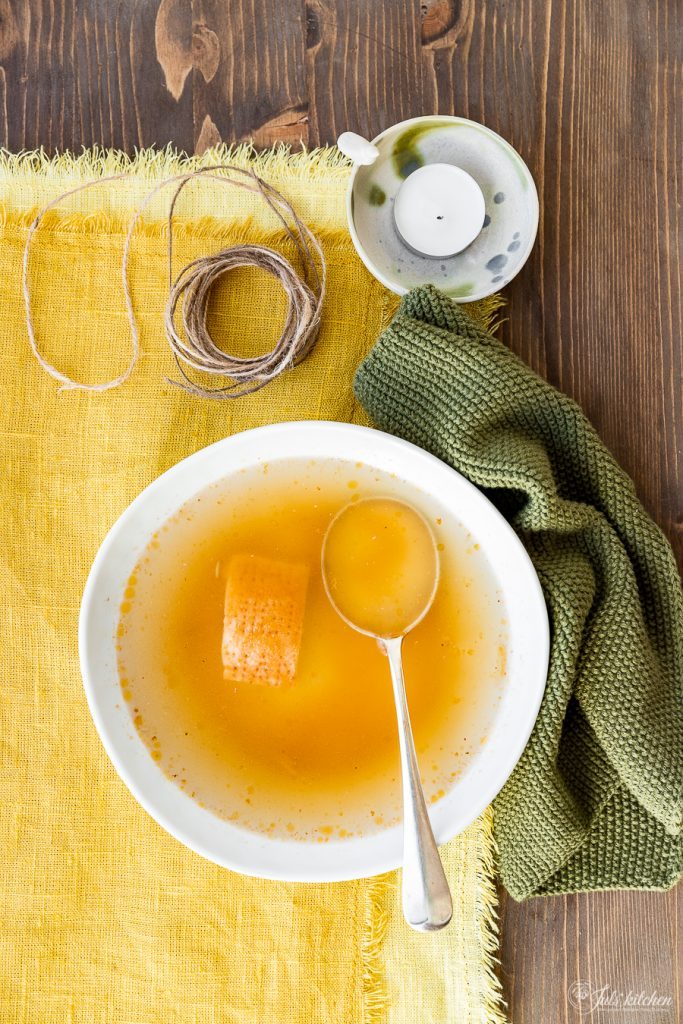
How many meals can you get from a chicken?
I chose a very large pot, filled it for two thirds with water and I threw inside a carrot, a stick of celery, a peeled onion, skewered with two cloves, a sprig of parsley and a teaspoon of tomato paste. I also added the carcass of a roast chicken that I had frozen some time ago: just like in the case of a boiled chicken, even the role of a roast chicken does not end when you have eaten all the meat.
Then I heated the water and, when it started boiling, I added a generous pinch of salt and the whole chicken. I lowered the heat and let it cook, covered, for at least three hours. The smell of chicken broth is just like that of ragù: it sticks to your bones, warms you from the inside out, comforts you, makes you travel back in time.
After three hours, the broth was yellow, rich in flavour. The meat of the chicken was juicy, you could shred it with a fork. In these that I hope may be the last windy days of winter cold, a chicken broth with pasta and a heaping tablespoon of grated Parmigiano is a comfort food that warms up the evening and soothes you, like a blanket. I had much more broth than I needed, so a part of that ended up in the freezer in a bottle, for a future risotto or soup, like this potato and artichoke vellutata.
Then, there is the meat.
I have a soft spot for chicken salads, you might remember this one, with preserved lemons and herbs. Using the meat of a whole chicken slowly cooked in the broth is incomparably better than cooking just the chicken breast. But if you are frightened by the idea of using a whole chicken, if you want smaller portions, or if you want to limit your budget, choose a chicken breast and a whole chicken leg and simmer them slowly with herbs, a carrot, a celery, an onion and a teaspoon of tomato paste.

Cannellini bean and chicken salad, with pickles and radicchio
With the chicken meat I made a salad that sits in between winter and spring, between the soothing comfort of beans and shredded chicken and the freshness of radicchio and pickled giardiniera. It reminds me of those spring days that are still cold, with a sharp wind but a clear sunny sky.
I served it as an appetiser with some toasted bread for a family lunch, with that slight hint of vinegar from the pickles that awakens the appetite. I also ate it as a main dish, adding more radicchio, madly in love with its bitter, clean taste.
A few words about the ingredients
I used a local variety of beans, they are creamy and tiny, with a thin skin. You can use cannellini beans or borlotti beans, or the beans you like the best.
The giardiniera I used in this recipe is homemade: I prepared it last summer following this recipe. The giardinierais a collection of pickled vegetables preserved in olive oil, basically it is a small vegetable garden in a jar: I usually choose the most representative vegetables of the season, then I quickly blanch them in a pot filled with water, vinegar, sugar and salt, and then I preserve them in extra virgin olive oil. What requires more time is usually to clean all the vegetables and cut them into small pieces, because the cooking is short and respectful. If you don’t have a homemade giardiniera, choose a good quality one, better if preserved in olive oil than in vinegar, otherwise the salad will be too sour.
The radicchio tardivo has a fleshy texture and a bitter taste that stands out in the salad. You can use your favorite radicchio, chicory or endive. Choose a leafy vegetable that has not only a bitter note, but also firm leaves, which do not disappear among the other strong flavours of the salad.
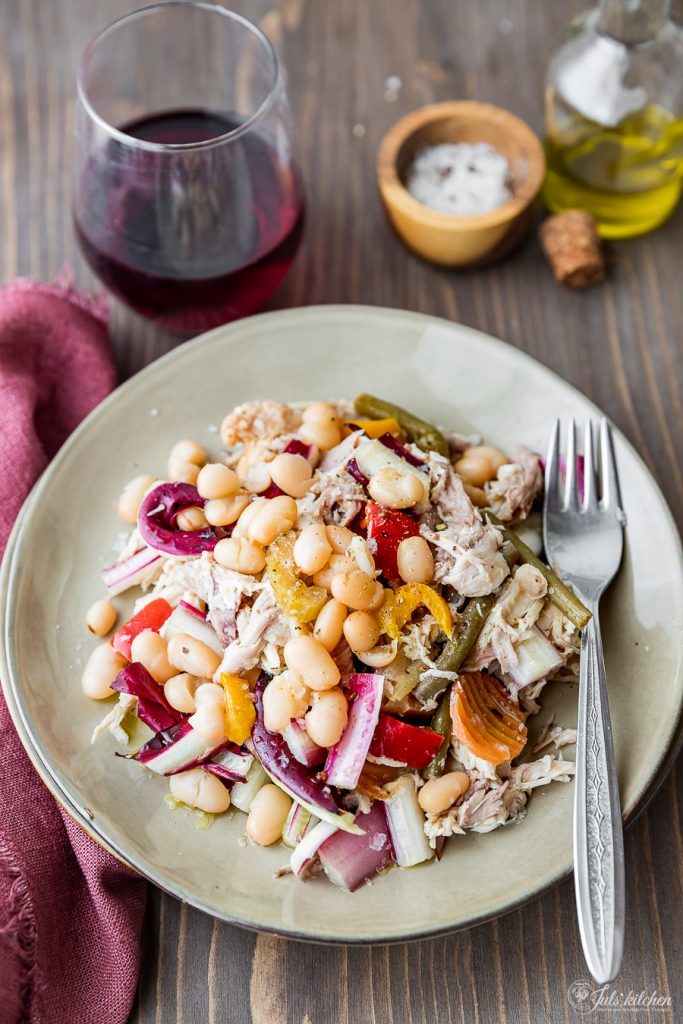
And now, the recipe. Once you have the boiled chicken and cannellini beans, the recipe is really quick and essential.
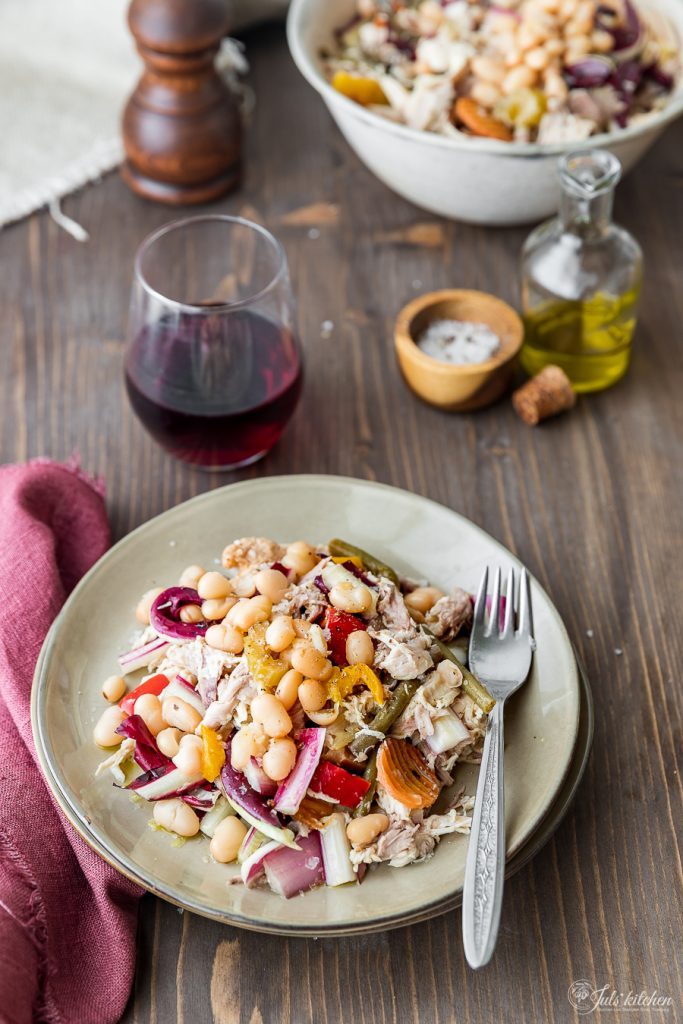
Cannellini bean and chicken salad, with pickles and radicchio
This bean and cannellini salad sits in between winter and spring, between the soothing comfort of beans and shredded chicken and the freshness of radicchio and pickled giardiniera. It reminds me of those spring days that are still cold, with a sharp wind but a clear sunny sky. CourseMain Course CuisineItalian Keywordsalad, beans, chicken, radicchio, pickles Prep Time10 minutes Resting time1 hour Servings people as a main course, 8-12 as an appetiser
Ingredients
- 550 g (1 ¼ lb) of boiled chicken
- 200 g (½ lb) of pickled giardiniera, well drained
- 250 g (½ lb) of radicchio
- 150 g (¾ cup – 5 ¼) oz of cannellini beans, already cooked
- Extra virgin olive oil
- Salt
- Freshly ground black pepper
Instructions
- Shred the cooked meat of the chicken with a fork. It will be way easier to shred the chicken when it is still warm, just removed from the hot broth. Why? It is not only easier to shred as it is softer, but the seasoning will soak the warm shredded chicken and all the ingredients will mingle in the salad, becoming one thing, and not separate ingredients who happened to be there in the bowl at the same time.
- Move the shredded chicken in a bowl and add the drained cannellini beans, the radicchio cut into strips and the drained giardiniera.
- Dress the salad with extra virgin olive oil, salt and pepper. Stir gently so as not to crush the beans, and leave the salad aside for about an hour before serving it, allowing the flavours to mingle.
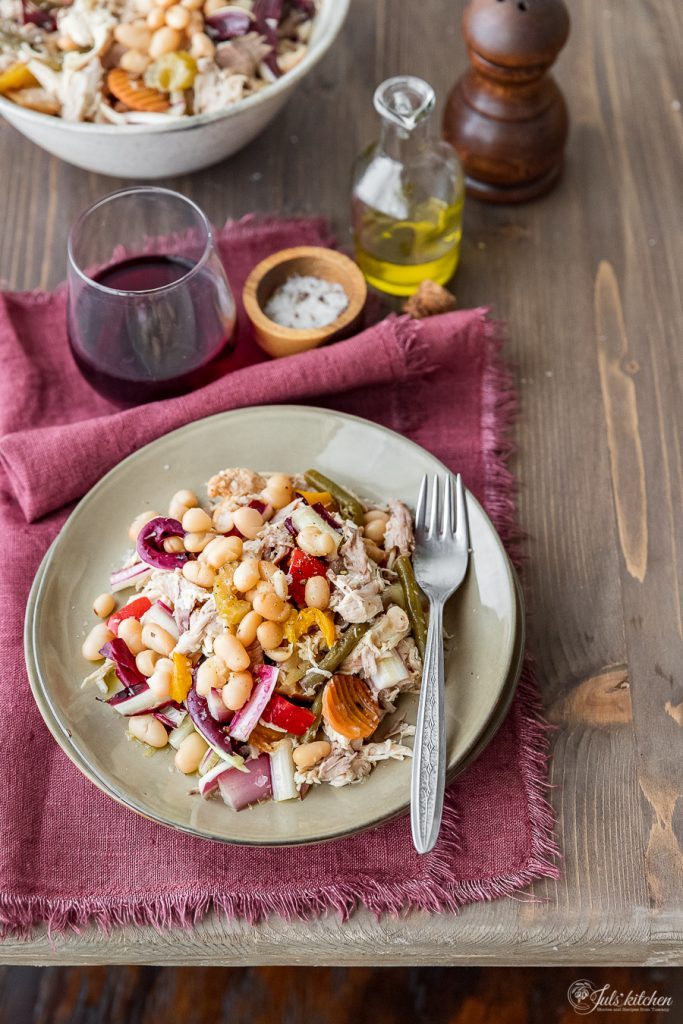
Serve the cannellini bean and chicken salad with…
Imagine a late winter day, just like now. The wind is still cold outside, but the sun is already heating the most sheltered corners. It is early to scout the market for spring vegetables, yet you already feel the need for clean, fresh tastes. This menu combines the comfort of winter recipes with that burning desire for spring that I’ve already been feeling for a few weeks now. To close the meal, a wholemeal crostata with lemon marmalade, a not to self to remind me that maybe it’s time to make a few jars of marmalade for the next crostate.
- Potato and artichoke soup. Artichokes are cooked with potatoes and leeks and half a cup of chicken broth, something I made some time ago and stored in the freezer. The soup can be served with more sautéed artichokes and golden bread croutons cooked with savory, or even with some toasted hazelnuts and almonds, if you want to keep the soup gluten free.
- Multigrain bread loaf. Serve the bean and chicken salad with a few slices of this wholesome multigrain bread loaf made with whole spelt flour, whole rye flour and whole buckwheat flour, all mixed together and shaped into a crusty loaf with some water and olive oil.
- Lemon marmalade crostata. It is easy to make a crostata, it doesn’t require special tools or any kind of skills. But it’s fun to deliberately complicate it: watch lost in your thoughts the cookie cutters and ask for advice on how to decorate it, ask for the help of a second pair of hands to gently lift the pastry and cut it into the cake tin.
Link love
- We’re trying to reduce the use of plastic at home. We’re just at the beginning of our crusade, but we’re finally trying to rationalise what we buy and use. One of the first changes has been the abandon of the easy and convenient (not for the price, though) coffee pods in favour of Chemex and Moka. Speaking of that, you might appreciate this article: The Humble Brilliance of Italy’s Moka Coffee Pot.
- This is a good year for book sequels! In April Joanne Harris will publish The Strawberry Thief, the fourth book of the Chocolat saga, and in September Cecilia Ahern will release Postscriptum, the sequel of P.S. I love you. I already preoredered both of them. I’m very excited about Joanne Harris’ book as she is a master in weaving food and writing in unforgettable books.
